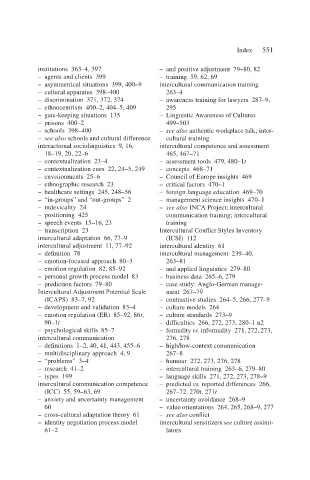Page 573 - Handbooks of Applied Linguistics Communication Competence Language and Communication Problems Practical Solutions
P. 573
Index 551
institutions 363–4, 397 – and positive adjustment 79–80, 82
– agents and clients 399 – training 59, 62, 69
– asymmetrical situations 399, 400–9 intercultural communication training
– cultural apparatus 398–400 263–4
– discrimination 371, 372, 374 – awareness training for lawyers 287–9,
– ethnocentrism 400–2, 404–5, 409 295
– gate-keeping situations 135 – Linguistic Awareness of Cultures
– prisons 400–2 499–503
– schools 398–400 – see also authentic workplace talk; inter-
– see also schools and cultural difference cultural training
interactional sociolinguistics 9, 16, intercultural competence and assessment
18–19, 20, 22–6 465, 467–71
– contextualization 23–4 – assessment tools 479, 480–1t
– contextualization cues 22, 24–5, 249 – concepts 468–71
– envisionments 25–6 – Council of Europe insights 469
– ethnographic research 23 – critical factors 470–1
– healthcare settings 245, 248–56 – foreign language education 469–70
– “in-groups” and “out-groups” 2 – management science insights 470–1
– indexicality 24 – see also INCA Project; intercultural
– positioning 425 communication training; intercultural
– speech events 15–16, 23 training
– transcription 23 Intercultural Conflict Styles Inventory
intercultural adaptation 66, 77–9 (ICSI) 112
intercultural adjustment 11, 77–92 intercultural identity 61
– definition 78 intercultural management 239–40,
– emotion-focused approach 80–3 263–81
– emotion regulation 82, 85–92 – and applied linguistics 279–80
– personal growth process model 83 – business data 265–6, 279
– prediction factors 79–80 – case study: Anglo-German manage-
Intercultural Adjustment Potential Scale ment 267–79
(ICAPS) 83–7, 92 – contrastive studies 264–5, 266, 277–9
– development and validation 83–4 – culture models 264
– emotion regulation (ER) 85–92, 86t, – culture standards 273–9
90–1t – difficulties 266, 272, 273, 280–1 n2
– psychological skills 85–7 – formality vs. informality 271, 272, 273,
intercultural communication 276, 278
– definitions 1–2, 40, 41, 443, 455–6 – high/low-context communication
– multidisciplinary approach 4, 9 267–8
– “problems” 3–4 – humour 272, 273, 276, 278
– research 41–2 – intercultural training 263–6, 279–80
– types 199 – language skills 271, 272, 273, 278–9
intercultural communication competence – predicted vs. reported differences 266,
(ICC) 55, 59–63, 69 267–72, 270t, 271t
– anxiety and uncertainty management – uncertainty avoidance 268–9
60 – value orientations 264, 265, 268–9, 277
– cross-cultural adaptation theory 61 – see also conflict
– identity negotiation process model intercultural sensitizers see culture assimi-
61–2 lators

